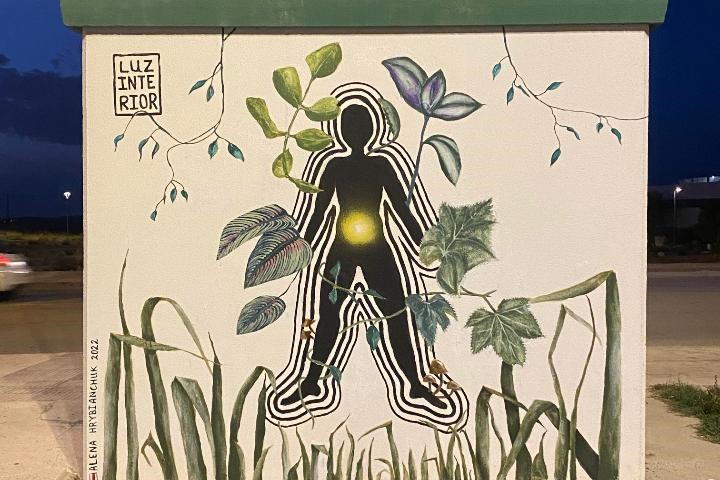When we spoke, artist Alena Hrybianchuk was about to leave for the town of Baena in Southern Spain. The 23-year-old Belarusian had big plans for her week-long trip, made possible thanks to a grant from the European Union’s EU4Culture programme. Not only did she hope for a valuable cultural exchange with local artists, but she had also set a tangible task — a joint mural.
In these times of war and the disruption of familiar ties between countries, our conversation at first seems like a strange greeting from the past, but no: in the autumn of 2022, cultural cross-border programmes of the European Union continue — including for Belarusians.
A personal initiative
“The project of the trip is individual; I am its author. I have already been to Baena on my own initiative, I also created a mural, and now the municipality itself has invited me to do it,” says Alena.Spain
The artist turned her idea into an application: in the spring of 2022, the first EU4Culture competition had just been announced. Alena’s project was successfully selected among 95 candidates, receiving funding among 33 other initiatives from Belarus.
Such programmes do not mean access to a ready-made set of activities such as exhibitions and conferences. Instead, they work with personal projects initiated by cultural figures, offering grants for the development of an artist’s own ideas, although these can be integrated into existing events. There are traditionally many similar initiatives in Europe, public and private: the system of cultural grants works both in individual countries and at the European level.
The peculiarity of this programme is that it is not a purely internal story, but a “cultural wing” of the Eastern Partnership, an EU policy with a 13-year history to improve ties between countries on the continent.
EU4Culture supports professionals in the field of culture from the Eastern Partnership, and everything is interpreted as broadly as possible: no one is shy about considering recent and even current students as professionals, and the “field of culture” is very broad.
“The value is not only in the ability to express yourself. You establish connections, get acquainted with like-minded people, create joint projects and immediately agree on their implementation. This is just as important,” Alena believes.
create joint projects'
According to her, Europeans are very interested in Belarusian culture: for the same Spaniards with whom the artist has worked before, Belarus is “something very distant, even exotic… Something they are willing to get acquainted with. Just because they don’t know anything about it.”
Mutual understanding
“We must keep feeling this pulse,” says Rūstis Kamuntavičius, curator of one of the Belarusian grant recipients in Kaunas, Lithuania.
Rūstis holds a PhD in History, and is Director of the Institute of the Grand Duchy of Lithuania. He explores the common past of Lithuanians, Poles, Belarusians and Ukrainians: in his opinion, one of the problems of today’s Europe is that people from different countries mutually know nothing about their neighbours. Therefore, our interlocutor does not consider such projects as charity at all.
“Of course, such projects are important for eastern neighbours of the European Union, but we cannot say that this is exclusively a help for them — the picture will be incomplete. This helps us, Europeans, too. We need to know our neighbours! In fact, since the collapse of the Soviet Union, we have not really delved into each other’s situation… And then, unexpectedly for us, a nuclear power plant suddenly emerged 30 kilometres from Vilnius. Then suddenly the war began. Now we are all thinking only about ending this war. But when it’s over, we’ll have to communicate somehow. If we don’t know each other, we won’t have academic and cultural contacts… We will face the same problems again. Every such visit of artists and activists, every scholarship, every common project — I think they are very important and needed by both sides,” explains Rūstis.
The scholar is not optimistic about the near future: in his opinion, it may well be even worse. This has long affected purely human relations.
However, the academic and cultural environment is still trying to maintain ties and mutual understanding of the situation, and EU4Culture plays a vital role in preserving this understanding.
An ongoing initiative
While this article was being prepared for publication, Alena published the result of her trip to Baena: as planned, the mural was painted together with Andalusian artists.
Alena’s project was one of 34 selected projects implemented by Belarusians within the EU4Culture framework in 2022, in total, the organisers received 95 applications. There will be new selections of candidates: the programme runs annually until 2024, and the next selection starts in January 2023. You can look out for the call and other similar opportunities here.
The rules will remain the same: any representatives of the cultural and creative sector can apply, and the duration of their mobility projects can vary from 7 days to 12 weeks: in addition, a set of applications with cultural and cross-innovative projects lasting up to a year and amounting from €3,000 to €25,000 is planned for 2023. Destination points are EU countries, EU partner countries and other European countries.







